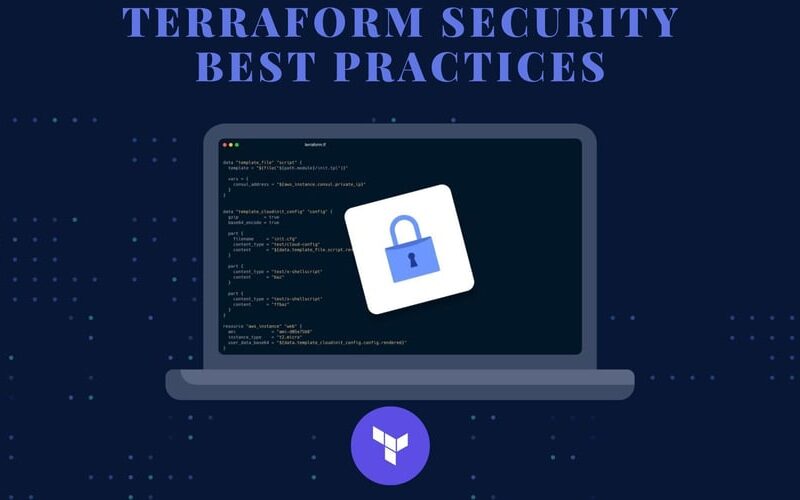With the increasing adoption of Infrastructure as Code (IaC) to manage cloud environments, most organizations have started using IaC tools, with Terraform as the preferred choice. Terraform is highly preferred for its versatility and multi-cloud support. However, managing the security posture with Terraform is critical, and not following proper security practices can easily expose sensitive data and resources.
In this article, I will cover the key Terraform security best practices that can help organizations, DevOps engineers, cloud architects, and security teams protect their infrastructure and maintain business continuity.
Top 8 Terraform Security Best Practices to Follow
Here are the eight key Terraform security best practices every organization should follow to secure their infrastructure while operating efficiently.
1. Secure Your Terraform State Files
Terraform state files contain a snapshot of your infrastructure, including sensitive information such as API keys, secrets, and resource configurations. Protecting these files is important to prevent your data from getting leaked and unauthorized users from accessing it.
- Use remote state storage with encryption (e.g., AWS S3 with bucket encryption or Terraform Cloud).
- Enable versioning in the backend of your state storage to track changes and recover from accidental deletions.
- Restrict access to the state file by applying strict IAM policies to limit who can view or modify it.
A compromised state file could expose your entire infrastructure, so treat it with the same level of caution as any sensitive data.
2. Manage Secrets Effectively
One of the most common Terraform security drawbacks is hardcoding sensitive information such as database credentials or API keys directly in Terraform configurations. This practice exposes your secrets to version control systems, logs, and anyone accessing your codebase.
- To manage and inject secrets securely, use third-party DevOps tools like HashiCorp Vault, AWS Secrets Manager, or Azure Key Vault.
- Do not store secrets in plaintext files or environment variables. Instead, use encrypted files or secure workflows for access.
- Rotate secrets regularly and enforce policies for strong, complex keys.
Separating secrets from your Terraform code will minimize the risk of accidental exposure or misuse and enhance the security of your code.
3. Implement Role-Based Access Control (RBAC)
Terraform operations often involve multiple teams with varying responsibilities. To maintain security, it is important to ensure that only authorized personnel can access and modify Terraform configurations.
- Implement role-based access control (RBAC) using platforms like Terraform Cloud or CI/CD tools like Jenkins or GitLab.
- Assign least-privilege roles to users, letting users only access the resources necessary for them.
- Regularly audit access permissions to ensure they align with the current responsibilities of your teams.
4. Use Verified Modules and Providers
Terraform’s modular approach promotes code reusability and collaboration, but depending on modules or providers that are not verified can expose users to security vulnerabilities.
- Source modules from trusted registries like the Terraform Registry or verified repositories.
- Conduct a manual review of module code to identify potential risks, such as hardcoded secrets.
- Pin specific versions of modules and providers in your configuration files to avoid unexpected updates.
Trustworthy modules and providers are the foundation of secure and reliable infrastructure management.
5. Scan Your Terraform Code for any Vulnerabilities
With the help of Static analysis tools, you can detect security misconfigurations or compliance violations in Terraform code before deployment and avoid making costly mistakes.
- Integrate tools like Checkov, tfsec, or Terraform Validator into your CI/CD pipeline for automated code scanning.
- Address flagged issues, particularly those classified as high or critical severity.
- Regularly update your scanning tools to stay abreast of any new vulnerabilities.
Proactively identifying risks reduces your exposure to security threats and improves overall code quality.
6. Validate your Configurations Before Applying Changes
- Always run the
terraform plancommand to validate configurations and catch potential issues. - Conduct peer reviews for all changes, leveraging pull requests and code reviews within version control systems.
- Maintain separate environments for testing and production to validate changes without affecting live resources.
Thorough validation processes ensure safe and predictable deployments.
7. Monitor and Log Terraform Activities
Visibility into Terraform operations is vital for identifying anomalies and maintaining compliance.
- Enable logging and monitoring for your Terraform backend, such as AWS CloudTrail or GCP Audit Logs.
- Set up alerts to detect suspicious activities, such as attempts by unauthorized users to access state files
- Use monitoring tools to track infrastructure changes, ensuring a clear audit trail for security reviews
Proper monitoring ensures that issues are detected and resolved before they escalate.
8. Leverage Community and Industry Resources
Continuously learning new things, staying up-to-date with the latest trends and practices, and staying connected with the community can help you stay ahead of the game.
- Stay up-to-date with Terraform’s official documentation for updates and guidance.
- Connect with the Terraform community via forums or GitHub to learn from the experiences of others.
- Participate in workshops and webinars to help your teams better understand secure IaC practices.
Conclusion
Keeping your Terraform workflows secure doesn’t need to be a tough task. By following Terraform security best practices—like protecting your state files, managing secrets properly, and scanning your code—you can significantly reduce risks and build a strong foundation for your infrastructure.
Consider hiring skilled Terraform developers to simplify this journey and get expert support. They can help you set up a secure and scalable infrastructure while allowing you to focus on your business priorities.
Source link
lol

